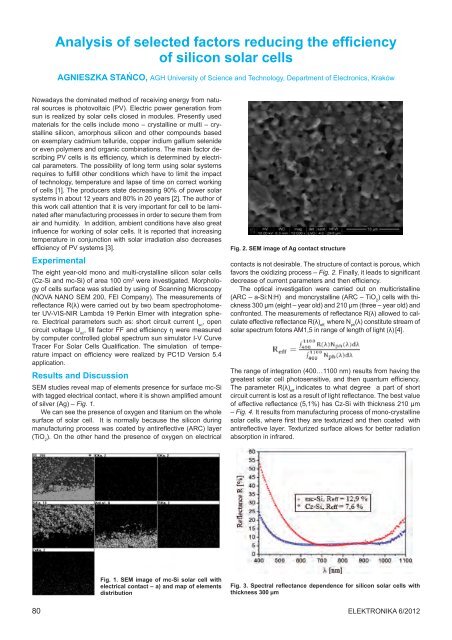Proceedings of the European Summer School of Photovoltaics 4 â 7 ...
Proceedings of the European Summer School of Photovoltaics 4 â 7 ...
Proceedings of the European Summer School of Photovoltaics 4 â 7 ...
You also want an ePaper? Increase the reach of your titles
YUMPU automatically turns print PDFs into web optimized ePapers that Google loves.
Analysis <strong>of</strong> selected factors reducing <strong>the</strong> efficiency<br />
<strong>of</strong> silicon solar cells<br />
Agnieszka Stańco, AGH University <strong>of</strong> Science and Technology, Department <strong>of</strong> Electronics, Kraków<br />
Nowadays <strong>the</strong> dominated method <strong>of</strong> receiving energy from natural<br />
sources is photovoltaic (PV). Electric power generation from<br />
sun is realized by solar cells closed in modules. Presently used<br />
materials for <strong>the</strong> cells include mono – crystalline or multi – crystalline<br />
silicon, amorphous silicon and o<strong>the</strong>r compounds based<br />
on exemplary cadmium telluride, copper indium gallium selenide<br />
or even polymers and organic combinations. The main factor describing<br />
PV cells is its efficiency, which is determined by electrical<br />
parameters. The possibility <strong>of</strong> long term using solar systems<br />
requires to fulfill o<strong>the</strong>r conditions which have to limit <strong>the</strong> impact<br />
<strong>of</strong> technology, temperature and lapse <strong>of</strong> time on correct working<br />
<strong>of</strong> cells [1]. The producers state decreasing 90% <strong>of</strong> power solar<br />
systems in about 12 years and 80% in 20 years [2]. The author <strong>of</strong><br />
this work call attention that it is very important for cell to be laminated<br />
after manufacturing processes in order to secure <strong>the</strong>m from<br />
air and humidity. In addition, ambient conditions have also great<br />
influence for working <strong>of</strong> solar cells. It is reported that increasing<br />
temperature in conjunction with solar irradiation also decreases<br />
efficiency <strong>of</strong> PV systems [3].<br />
Experimental<br />
The eight year-old mono and multi-crystalline silicon solar cells<br />
(Cz-Si and mc-Si) <strong>of</strong> area 100 cm 2 were investigated. Morphology<br />
<strong>of</strong> cells surface was studied by using <strong>of</strong> Scanning Microscopy<br />
(NOVA NANO SEM 200, FEI Company). The measurements <strong>of</strong><br />
reflectance R(λ) were carried out by two beam spectrophotometer<br />
UV-VIS-NIR Lambda 19 Perkin Elmer with integration sphere.<br />
Electrical parameters such as: short circuit current I sc<br />
, open<br />
circuit voltage U oc<br />
, fill factor FF and efficiency η were measured<br />
by computer controlled global spectrum sun simulator I-V Curve<br />
Tracer For Solar Cells Qualification. The simulation <strong>of</strong> temperature<br />
impact on efficiency were realized by PC1D Version 5.4<br />
application.<br />
Results and Discussion<br />
SEM studies reveal map <strong>of</strong> elements presence for surface mc-Si<br />
with tagged electrical contact, where it is shown amplified amount<br />
<strong>of</strong> silver (Ag) – Fig. 1.<br />
We can see <strong>the</strong> presence <strong>of</strong> oxygen and titanium on <strong>the</strong> whole<br />
surface <strong>of</strong> solar cell. It is normally because <strong>the</strong> silicon during<br />
manufacturing process was coated by antireflective (ARC) layer<br />
(TiO 2<br />
). On <strong>the</strong> o<strong>the</strong>r hand <strong>the</strong> presence <strong>of</strong> oxygen on electrical<br />
Fig. 2. SEM image <strong>of</strong> Ag contact structure<br />
contacts is not desirable. The structure <strong>of</strong> contact is porous, which<br />
favors <strong>the</strong> oxidizing process – Fig. 2. Finally, it leads to significant<br />
decrease <strong>of</strong> current parameters and <strong>the</strong>n efficiency.<br />
The optical investigation were carried out on multicristalline<br />
(ARC – a-Si:N:H) and moncrystalline (ARC – TiO 2<br />
) cells with thickness<br />
300 µm (eight – year old) and 210 µm (three – year old) and<br />
confronted. The measurements <strong>of</strong> reflectance R(λ) allowed to calculate<br />
effective reflectance R(λ) eff,<br />
where N ph<br />
(λ) constitute stream <strong>of</strong><br />
solar spectrum fotons AM1,5 in range <strong>of</strong> length <strong>of</strong> light (λ) [4].<br />
The range <strong>of</strong> integration (400…1100 nm) results from having <strong>the</strong><br />
greatest solar cell photosensitive, and <strong>the</strong>n quantum efficiency.<br />
The parameter R(λ) eff<br />
indicates to what degree a part <strong>of</strong> short<br />
circuit current is lost as a result <strong>of</strong> light reflectance. The best value<br />
<strong>of</strong> effective reflectance (5,1%) has Cz-Si with thickness 210 µm<br />
– Fig. 4. It results from manufacturing process <strong>of</strong> mono-crystalline<br />
solar cells, where first <strong>the</strong>y are texturized and <strong>the</strong>n coated with<br />
antireflective layer. Texturized surface allows for better radiation<br />
absorption in infrared.<br />
80<br />
Fig. 1. SEM image <strong>of</strong> mc-Si solar cell with<br />
electrical contact – a) and map <strong>of</strong> elements<br />
distribution<br />
Fig. 3. Spectral reflectance dependence for silicon solar cells with<br />
thickness 300 µm<br />
Elektronika 6/2012

















